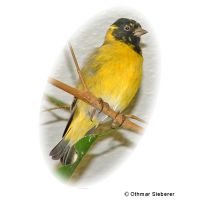Hooded Siskin (Spinus magellanicus)
| Hooded Siskin Spinus magellanicus | |
|---|---|
| Name | Hooded Siskin |
| Name Lat. | Spinus magellanicus |
| Synonym | Carduelis magellanica |
| Family | Finches and Allies |
| Family lat. | Fringillidae |
| Order | Perching Birds |
| Order lat. | Passeriformes |
| Origin | South America |
| Climate | Temperate - tropical |
| Diet | Finch seed, veggies, insects |
| Keeping | Pair, group |
| Care Level | Moderate |
| Reproduction | Cup nest |
| Life Span | 6-12 years |
| Protection | No |
| Metric Units | |
| Size | 11 cm |
| Temperature | Room temperature |
| Housing | 80 x 40 x 40 cm |
| US Units | |
| Size | 4.3" |
| Temperature | Room temperature |
| Housing | 30" x 15" x 15" |
Distribution and habitat
The range of the Magellanic Siskin extends from southern Colombia through Ecuador and N Chile to Argentina and Uruguay. They live in open landscapes with trees and bushes up to 4000 m altitude. Today they are only available as a breeding form.
Cage size
The minimum cage size is 80 x 40 x 40 cm (L x W x H) for a pair. The cage size must not be undercut even in case of justified single keeping. For an additional 2 birds, assuming species compatibility, the floor space must be increased by 25%. The cage must be placed in a bright, draught-free and quiet place at a height of at least 80 cm (except aviaries), have a rectangular base and be opaque on three sides, aviaries on one side. Keeping in an aviary is preferable.
Maintenance
The ground must be covered with sand, leaves, wood granulate, bark mulch or similar material and must be cleaned regularly. They need perching, hiding, roosting and nesting opportunities, as well as biotope-like furnishings with grasses, shrubbery and natural planting. At least 3 perches made of wood or branches of varying thickness and height must be installed in such a way that they can only be reached by flying and that the longest possible flight distance is created. Bathing facilities must be available at all times. The room temperature should not fall below 15 °C.
Diet
The species-specific food offer consists of mixed seeds, available in specialized trade as "siskin food" in premium quality, supplemented with foxtail millet, green food (chickweed, green panicle millet, fresh grass panicles, cucumber slices, organic lettuce etc.), tangle grass seeds, insect food and especially germinated seeds (e.g. millet).), tangle grass seeds, insect food and, especially for raising young, germinated seeds (e.g. millet), egg food and insect larvae, such as small, skinned, cut-up mealybug larvae, ant pupae, small buffalos and aphids. Charcoal, vitamine lime, and shell grit are needed as digestive aids. Drinking water must always be available in birdbaths or in stable, open containers. Food and water must be offered fresh daily, and the containers must be cleaned beforehand.
A varied diet promotes health and prevents deficiency symptoms.
Reproduction and breeding
The sexes are easy to identify, females are majority gray-green and have no black head markings.
They like to breed in open nesting baskets or also freely in the branches. Suitable nesting material is sisal, jute fibers, moss, sharpie solid and animal hair. The clutch consists of 4-5 eggs, the incubation period is about 13 days. For breeding the room temperature should be at least 18 °C.
Important
The birds may only be kept in pairs or groups
Keeping in a round cage is not allowed. For keeping in a group, an aviary is required.
They may be kept year-round in outdoor aviaries (minimum height 1.70 m), provided that a dry and draft-free shelter or a covered, protected aviary section is available to them. The facilities must be the same as those for cages.
In rooms, sufficient daylight or flicker-free artificial light (stroboscopic effect), corresponding to the light spectrum of natural sunlight, must be provided. The lighting duration must be between 8 and 14 hours per day. The day-night rhythm must be observed. An adequate indoor climate must be provided. The health condition of the birds must be checked daily.
Further literature can be found in your pet store.
References
Text: Othmar Sieberer; Image: Othmar Sieberer
Source: BMELV (1995): Tierschutzgutachten - Mindestanforderungen an die Haltung von Kleinvögeln; CLASSEN & MASSOTH (1992): Handbuch der Cardueliden, Band 1, Hanke Verlag; GRUMMT & STREHLOW (2009): Zootierhaltung - Tiere in menschlicher Obhut: Vögel, Verlag Harri Deutsch
- Gemäß § 21 Abs. 5 Tierschutzgesetz idgF
